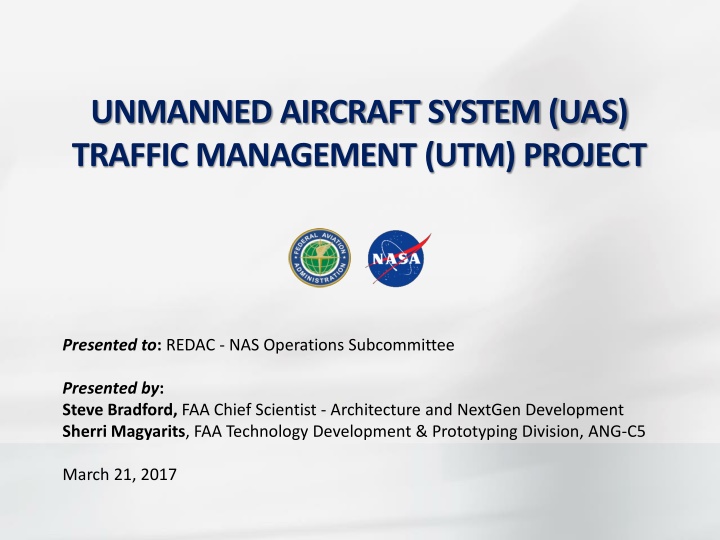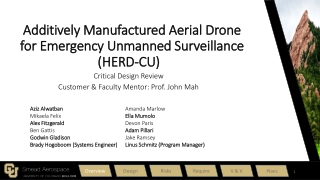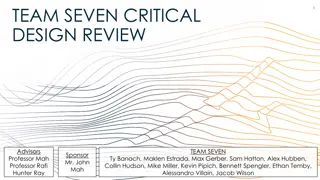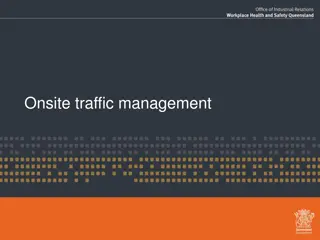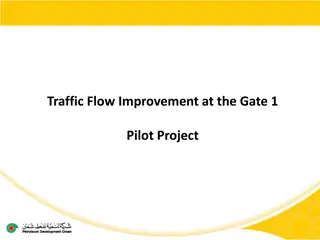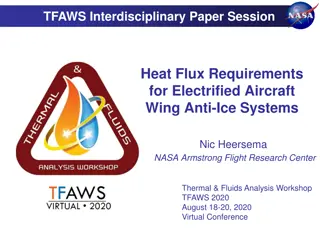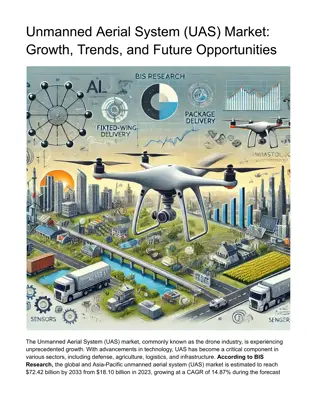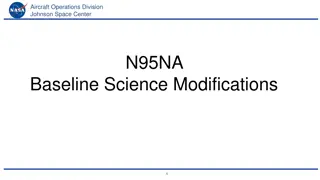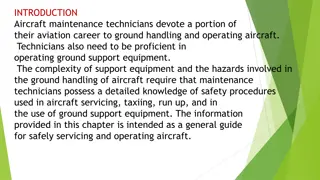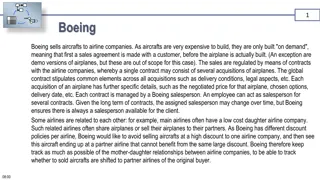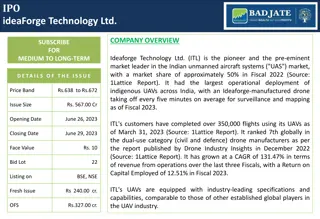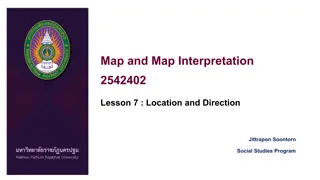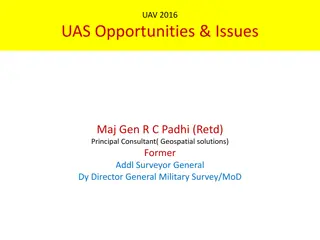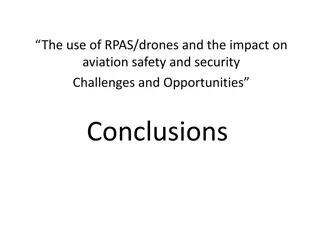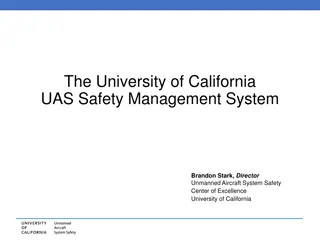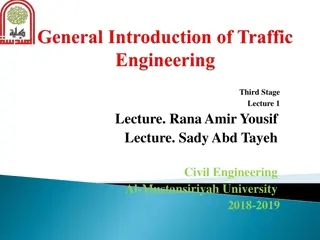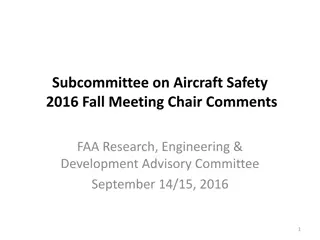UNMANNED AIRCRAFT SYSTEM (UAS) TRAFFIC MANAGEMENT (UTM) PROJECT
UTM is an ecosystem for managing low-altitude uncontrolled UAS operations, addressing critical gaps in support and enabling multiple BVLOS operations. It utilizes industry services under FAA's authority to enhance public safety and ensure coordination between manned and unmanned aircraft. The integration of UTM principles and services provides higher density UAS operations, BVLOS capabilities, exception handling, and coordination with FAA NAS systems.
Download Presentation

Please find below an Image/Link to download the presentation.
The content on the website is provided AS IS for your information and personal use only. It may not be sold, licensed, or shared on other websites without obtaining consent from the author.If you encounter any issues during the download, it is possible that the publisher has removed the file from their server.
You are allowed to download the files provided on this website for personal or commercial use, subject to the condition that they are used lawfully. All files are the property of their respective owners.
The content on the website is provided AS IS for your information and personal use only. It may not be sold, licensed, or shared on other websites without obtaining consent from the author.
E N D
Presentation Transcript
UNMANNED AIRCRAFT SYSTEM (UAS) TRAFFIC MANAGEMENT (UTM) PROJECT Presented to: REDAC - NAS Operations Subcommittee Presented by: Steve Bradford, FAA Chief Scientist - Architecture and NextGen Development Sherri Magyarits, FAA Technology Development & Prototyping Division, ANG-C5 March 21, 2017
What is UTM? UTM is an traffic management ecosystem for uncontrolled operations UTM is separate, but complementary system to the Air Traffic Management (ATM) system UTM utilizes industry s ability to supply services under FAA s regulatory authority where these services do not exist UTM development will ultimately identify services, roles/responsibilities, information architecture, data exchange protocols, software functions, infrastructure, and performance requirements for enabling the management of low-altitude uncontrolled UAS operations How to enable multiple BVLOS operations in low-altitude airspace? UTM addresses critical gaps associated with lack of support for uncontrolled operations 2
UTM Principles &Services for Safe Integration Principles Users operate in airspace volumes as specified in authorizations Authorizations are issued based on type of operation & operator/vehicle performance UAS stay clear of each other UAS and manned aircraft stay clear of each other UAS operator has complete awareness of airspace and other constraints Public safety UAS have priority over other UAS Key UAS-related services Authentication Airspace configuration and static and dynamic geo-fence definitions Weather and wind prediction and sensing Conflict avoidance (e.g., airspace notification) Demand/capacity management Large-scale contingency management (e.g., GPS or cell outage) 3
Value of UTM Higher density UAS operations Beyond visual light of sight (BVLOS) UAS operations Manned and unmanned vehicle operations coordination Unmanned vehicle operations coordination through agreed upon data/information exchanges about each others operations and with FAA NAS systems Exceptions handling Beyond Part 107 operations e.g, entry into controlled airspace 4
UTM Research Transition Team (RTT) UTM FAA & NASA Research Transition Team (RTT) formed March 2016 RTTs Ensure that research and development needed for Next Generation Air Transportation System (NextGen) implementation is identified, conducted, and effectively transferred to the implementing agency Provide a structured forum for researchers and implementers to constructively work together on a continuing basis Ensure that research results will be fully utilized, and will be sufficient to enable implementation of NextGen air navigation services concepts Include key NASA and FAA stakeholders who are responsible for planning, conducting, receiving, and utilizing the research conducted by the RTT 5
UTM RTT Overview Overarching Goals Explore concepts, develop prototypes, and demonstrate a possible future UTM system to enable large-scale low altitude UAS operations Define the operational concept, services, roles/responsibilities, information architecture, data exchange protocols, software functions, infrastructure, and performance requirements for low altitude UAS operations Execution March 2016 December 2020 Aligns with NASA UTM Project timeframe Results of this project are expected to be transitioned to the FAA for further testing and implementation 6
UTM RTT Objectives Conduct research, development, and testing to identify airspace operations requirements that enable large-scale visual and beyond visual line of sight UAS operations in the low-altitude airspace Collaborate across government agencies Collaborate with industry, leverage capabilities and insights more so than any other RTT Use UTM research platform for simulations and tests Partner with FAA UAS test ranges Use build-a-little-test-a-little strategy remote areas to urban areas Low density - No traffic management required but understanding of airspace constraints Cooperative traffic management - Understanding of airspace constraints and other operations Manned and unmanned traffic management - Scalable and heterogeneous operations Ensure UTM RTT approach offers path towards scalability 7
UTM RTT Scope UTM focuses on a self-managed environment: Uncontrolled airspace & uncontrolled operations inside controlled airspace Entry point - small UAS (Part 107 < 55lbs) although weight is not a factor for UTM ATM Established policies & procedures Beyond visual line of sight (BVLOS) of the operator - expanded operations Airspace where the FAA does not interact directly (e.g., no controller clearances to each vehicle) UTM Cooperative interaction Low altitudes initial focus is at or below 400 ft AGL potentially scales to other airspace All airspace classes (B, C, D, E, & G) except Class A - initial focus is Class G, uncontrolled airspace 8
UTM RTT Approach Data Exchange & Information Architecture Concepts & Use Cases UTM RTT Working Groups Communications & Navigation Sense & Avoid 9
Alignment with UTM Project Technical Capability Levels (TCLs) CAPABILITY 1: DEMONSTRATED HOW TO ENABLE MULTIPLE OPERATIONS UNDER CONSTRAINTS CAPABILITY 3: FOCUSES ON HOW TO ENABLE MULTIPLE HETEROGENEOUS OPERATIONS Notification of area of operation Over unpopulated land or water Minimal general aviation traffic in area Contingencies handled by UAS pilot Beyond visual line of sight/expanded Over moderately populated land Some interaction with manned aircraft Tracking, V2V, V2UTM and internet connected Product: Overall con ops, architecture, and roles Product: Requirements for heterogeneous operations CAPABILITY 2: DEMONSTRATED HOW TO ENABLE EXPANDED MULTIPLE OPERATIONS CAPABILITY 4: FOCUSES ON ENABLING MULTIPLE HETEROGENEOUS HIGH DENSITY URBAN OPERATIONS Beyond visual line-of-sight Tracking and low density operations Sparsely populated areas Procedures and rules-of-the road Longer range applications Beyond visual line of sight Urban environments, higher density Autonomous V2V, internet connected Large-scale contingencies mitigation Urban use cases Product: Requirements for multiple BVLOS operations Product: Requirements to manage contingencies in high density, heterogeneous, and constrained operations 10
UTM RTT Focus Areas Objectives Develop and establish consensus on operational concepts Airspace framework to guide RTT development Operating principles & assumptions Use cases Allocation of responsibilities to operators and FAA Concepts & Use Cases Provide input to RTT working groups and ensure consistency in scope and integrity of UTM concept Identify joint validation/demonstration opportunities Expected Outcomes Agreed upon concept for UTM, including roles & responsibilities associated with entities interacting with UTM, and operational requirements for UTM operations 11
UTM RTT Focus Areas (cont'd) Objectives Identify and collaboratively develop standards for the data/information needed across stakeholders to support safe and efficient UAS operations Operator - Operator Operator - NAS/ATM systems Data Exchange & Information Architecture Explore information architecture options that meet FAA needs to access information when needed or make information available to UTM operators Expected Outcomes Data exchange standards Information architecture requirements 12
UTM RTT Focus Areas (cont'd) Objectives Explore operator solutions to ensure that UA are under operational control of the pilot (to the degree appropriate to the operation) and remain within a defined area Address Command & Control, Navigation/Positioning, Compliance & Data Collection Communications & Navigation Expected Outcomes Guidance to industry on performance and test methodologies for maintaining operational control and remaining in designated areas or routes Best practices for collecting and aggregating navigation and communication performance data 13
UTM RTT Focus Areas (cont'd) Objectives Explore operator solutions to ensure that UA do not collide with other aircraft (UA or manned aircraft). Address Operational Coordination (sharing of intent information and sense & avoid capabilities), Compliance & Data Collection Sense & Avoid Expected Outcomes Guidance to industry for Assuring collision avoidance in dense drone environments Determining minimum separation standards for various technology solutions System performance for avoiding manned aircraft Best practices for collecting and aggregating sense & avoid data 14
UTM RTT Collaboration NASA Industry FAA Concept of operations Overall UTM information architecture and data exchange definition UTM research platform, flight test planning and execution Performance requirements for operations including planning, scheduling, track/locate, sense & avoid Use cases and operational needs Readiness of technologies (e.g., sense & avoid) Validation of the concept of operations Participation in flight tests and demonstration Technology options for vehicle Subject matter expertise Concept of operations Information requirements Roles/responsibilities definition Integration & interoperability needs Engagement on potential solutions 15
UTM RTT Tech Transfer Outputs Tech transfer - to FAA and industry Required data exchange and supporting information architecture, with emphasis on Requirements for multiple, coordinated BVLOS operations Concepts and initial requirements for multiple, coordinated BVLOS operations - operating with other UAS and manned aircraft Tech transfer - to FAA Flight Information Management System prototype Joint FAA-NASA UTM Pilot Program 16
Reauthorization Actions/Deliverable Updates UTM Research Plan Identified research outcomes sought The FAA Extension, The FAA Extension, Safety, and Security Act of Safety, and Security Act of 2016 calls for the 2016 calls for the development of a development of a Research Plan Research Plan for development development and and deployment deployment Ensured consistency with existing regulatory and operational frameworks and considered potential future frameworks for UTM UTM Assessing interoperability of proposed UTM system with existing and potential future air traffic management systems and processes Within 60 Within 60 days enactment (September 13, enactment (September 13, 2016): 2016): initiate research initiate research plan development plan development days after after UTM RTT Research Plan v1.0 finalized with updates to comments from the FAA Aviation Safety s (AVS) UAS Integration Office (AUS), Office of the Chief Counsel (AGC), and Government & Industry Affairs (AGI) organizations. Within Within 180 days after 180 days after enactment enactment (January 11, (January 11, 2017): 2017): complete research complete research plan, post to FAA website, plan, post to FAA website, and submit to Congress and submit to Congress Status: Memo signed and ready to be delivered 18
Reauthorization Actions/Deliverable Updates UTM Pilot Program Develop and demonstrate an infrastructure supporting UTM operations - that will be used for sharing of intent information between FAA airspace and UTM operational airspace The FAA Extension, The FAA Extension, Safety, and Security Act of Safety, and Security Act of 2016 calls for the 2016 calls for the establishment of the UTM establishment of the UTM System System Pilot Program Pilot Program within 90 days after within 90 days after completion of research completion of research plan (April 11, 2017) plan (April 11, 2017) Provide an understanding for level of investment required for UTM operations Support the tech transfer of the Flight Information Management System (FIMS) to the FAA and information requirements to the operators/suppliers Within Within 180 days of 180 days of establishment of pilot establishment of pilot program: submit update program: submit update on status and progress on status and progress (October 8, (October 8, 2017) 2017) Conclude in 2019 with an infrastructure left behind to support the investment plan for implementation Conclude Conclude pilot program pilot program not later than two years not later than two years after establishment after establishment Status: Planning on track for April 2017 definition 19
Reauthorization Actions/Deliverable Updates UTM Pilot Program (cont d) Responsibility Demonstration Areas UAS Service Supplier (USS) Industry / NASA UAS Operator Industry FIMS Prototype NASA / FAA (ANG/PMO) Procedures/Rules for Applicable Airspaces Industry / FAA (ATO/AFS) Backup Communications - Procedural Industry / FAA (AIR) Backup Surveillance Human Observers for Expanded Operations (BVLOS) Industry / FAA (AUS) 20
Critical Technology Enablers Hobbyist, VLOS (Part 101-E) Commercial Small UAS, VLOS (Part 107 and Ops over People Rule) BVLOS / Extended Operations (Part 107.xx) Integrated (Part xx) Increasing Operational Risk, Complexity & Cost Drivers Pathfinder 3 BVLOS Dynamic Spectrum Allocations for Command & Control Pathfinder 2 EVLOS Ground Based Sense & Avoid Pathfinder 1 VLOS Over People Low Altitude Automation and Scheduling (UTM) Automated Airspace Notification & Authorization Tools ATM System Integration Online Airspace Authorization Registration Website Airborne Detect & Avoid Geo-fencing Technologies Commercial BVLOS Hobbyist Commercial VLOS Integrated Sectors Framework Public 23
